An Integrated Method for Evaluation of Salt Tolerance in a Tall Wheatgrass Breeding Program
Abstract
:1. Introduction
2. Results
2.1. Seed Germination Rate of Tall Wheatgrass Responding to NaCl, Na2SO4, NaHCO3, and Na2CO3
2.2. Seedling Emergence Rate of Tall Wheatgrass Responding to NaCl and Saline Water
2.3. Seedling Growth of Tall Wheatgrass Responding to NaCl Stress
2.4. The Effects of Seedling Age and Growth Light Intensity on Evaluation of Salt Tolerance in Tall Wheatgrass
2.5. Differential Expression of Salt-Response Genes in Tall Wheatgrass Seedlings Under Salt Stress
2.6. Expression of Salt-Response Genes in Salt-Tolerant and Salt-Sensitive Tall Wheatgrass Lines
2.7. Evaluation of Salt Tolerance in 28 Tall Wheatgrass Lines
2.8. Evaluation of Salt Tolerance in Five Tritipyrum Lines Derived from Wheat × Tall Wheatgrass
3. Discussion
3.1. Seed Germination Rate Under Salt Stress as a Salt Tolerance Index in Tall Wheatgrass
3.2. Seedling Emergence Rate Under Salt Stress as Salt Tolerance Index in Tall Wheatgrass
3.3. Seedling Growth Under Salt Stress as Salt Tolerance Index in Tall Wheatgrass
3.4. Differential Expression of Salt-Response Genes in Tall Wheatgrass Under Salt Stress
3.5. Screening of Salt-Tolerant Lines of Tall Wheatgrass for Breeding Purpose
4. Materials and Methods
4.1. Plant Materials
4.2. Evaluation of Seed Germination of Tall Wheatgrass Under Salt Stress
- Germination rate = (number of germinated seeds/50) × 100%;
- Germination potential = (number of germinated seeds at 4 DAT/50) × 100%;
- Germination index = (sum of germinated seeds at 15 DAT)/15;
- Vigor index = germination index × mean shoot height;
- Relative salt damage rate = [(germination rate of control − germination rate of treatment)/germination rate of control] × 100%.
4.3. Evaluation of Seedling Emergence of Tall Wheatgrass Under Salt Stress
4.4. Evaluation of Seedling Growth of Tall Wheatgrass Under Salt Stress
4.5. Total RNA Extraction and First-Strand cDNA Synthesis
4.6. qPCR Assay for Relative Gene Expression
4.7. Tall Wheatgrass Lines and Tritipyrum Lines Evaluation
4.8. Statistical Analysis
5. Conclusions
Supplementary Materials
Author Contributions
Funding
Data Availability Statement
Conflicts of Interest
Abbreviations
| DAT | Days after treatment |
| RDW | Root dry weight |
| RFW | Root fresh weight |
| SDW | Shoot dry weight |
| SER | Seedling emergence rate |
| SFW | Shoot fresh weight |
| TDW | Total dry matter weight |
| TFW | Total fresh matter weight |
References
- Asay, K.H.; Jensen, K.B. Wheatgrasses. In Cool-Season Forage Grasses; Moser, L.E., Buxton, D.R., Casler, M.D., Eds.; ASA, CSSA, and SSSA: Madison, WI, USA, 1996; pp. 691–724. [Google Scholar]
- Andrioli, R.J. Adaptive mechanisms of tall wheatgrass to salinity and alkalinity stress. Grass Forage Sci. 2023, 78, 23–36. [Google Scholar]
- Falasca, S.L.; Miranda, C.; Alvarez, S.P. Agro-ecological zoning for tall wheatgrass (Thinopyrum ponticum) as a potential energy and forage crop in salt-affected and dry lands of Argentina. Arch. Crop Sci. 2017, 1, 10–19. [Google Scholar]
- Dewey, D.R. Salt tolerance of twenty-five strains of Agropyron. Agron. J. 1960, 52, 631–635. [Google Scholar] [CrossRef]
- Carter, D.L.; Peterson, H.B. Sodic tolerance of tall wheatgrass. Agron. J. 1962, 54, 382–384. [Google Scholar]
- Temel, S.; Keskın, B.; Sımsek, U.; Yılmaz, I.H. Performance of some forage grass species in halomorphic soil. Turk. J. Field Crops. 2015, 20, 131–141. [Google Scholar]
- Shahid, S.A.; Al-Shankiti, A. Sustainable food production in marginal lands—Case of GDLA member countries. Int. Soil Water Conserv. Res. 2013, 1, 24–38. [Google Scholar]
- Ciria, C.S.; Sastre, C.M.; Carrasco, J.; Ciria, P. Tall wheatgrass (Thinopyrum ponticum (Podp)) in a real farm context, a sustainable perennial alternative to rye (Secale cereale L.) cultivation in marginal lands. Ind. Crops Prod. 2020, 146, 112184. [Google Scholar]
- Nazli, R.I.; Kusvuran, A.; Tansi, V.; Ozturk, H.H.; Budak, D.B. Comparison of cool and warm season perennial grasses for biomass yield, quality, and energy balance in two contrasting semiarid environments. Biomass Bioenergy 2020, 139, 105627. [Google Scholar]
- Cao, X.; Sun, B.; Chen, H.; Zhou, J.; Song, X.; Liu, X.; Deng, X.; Li, X.; Zhao, Y.; Zhang, J.; et al. Approaches and research progresses of marginal land productivity expansion and ecological benefit improvement in China. Bull. Chin. Acad. Sci. 2021, 36, 336–348. [Google Scholar]
- Scordia, D.; Papazoglou, E.G.; Kotoula, D.; Sanz, M.; Ciria, C.S.; Pérez, J.; Maliarenko, O.; Prysiazhniuk, O.; Von Cossel, M.; Greiner, B.E. Towards identifying industrial crop types and associated agronomies to improve biomass production from marginal lands in Europe. GCB Bioenergy 2022, 14, 710–734. [Google Scholar]
- Xu, W.; Wang, J.; Liu, X.; Xie, Q.; Yang, W.; Cao, X.; Li, Z. Scientific and technological reasons, contents and corresponding policies of constructing “Coastal Grass Belt”. Bull. Chin. Acad. Sci. 2022, 37, 238–245. [Google Scholar]
- Wang, T.; Cao, L.; Liu, Z.; Yang, Q.; Chen, L.; Chen, M.; Jing, H. Forage grass basic biology of constructing Coastal Grass Belt. Chin. Bull. Bot. 2022, 57, 837–847. [Google Scholar]
- Li, H.; Zheng, Q.; Wang, J.; Sun, H.; Zhang, K.; Fang, H.; Xing, X.; Yang, W.; Cao, X.; Liu, X. Industrialization of tall wheatgrass for construction of “Coastal Grass Belt”. Bull. Chin. Acad. Sci. 2023, 38, 622–631. [Google Scholar]
- Munns, R.; Tester, M. Mechanisms of salinity tolerance. Annu. Rev. Plant Biol. 2008, 59, 651–681. [Google Scholar] [CrossRef]
- Shannon, M.C. Testing salt tolerance variability among tall wheatgrass lines. Agron. J. 1978, 70, 719–722. [Google Scholar]
- Mcguire, P.E.; Dvôrák, J. High salt tolerance potential in wheatgrasses. Crop Sci. 1981, 21, 702–705. [Google Scholar]
- Roundy, B.A. Response of basin wildrye and tall wheatgrass seedlings to salination. Agron. J. 1983, 75, 67–71. [Google Scholar]
- Suyama, H.; Benes, S.E.; Robinson, P.H.; Getachew, G.; Grattan, S.R.; Grieve, C.M. Biomass yield and nutritional quality of forage species under long-term irrigation with saline-sodic drainage water: Field evaluation. Anim. Feed Sci. Technol. 2007, 135, 329–345. [Google Scholar]
- Bernstein, L.; Ford, R. Salt tolerance of forage crops. In Uited States Salinity Lab Report to Collaborators; Riverside, CA, USA, 1958; pp. 32–36. [Google Scholar]
- Riedell, W.E. Growth and ion accumulation responses of four grass species to salinity. J. Plant Nutr. Soil Sci. 2016, 39, 2115–2125. [Google Scholar] [CrossRef]
- Borrajo, C.I.; Sánchez-Moreiras, A.M.; Reigosa, M.J. Ecophysiological responses of tall wheatgrass germplasm to drought and salinity. Plants 2022, 11, 1548. [Google Scholar] [CrossRef]
- Li, H.; Li, W.; Zheng, Q.; Zhao, M.; Wang, J.; Li, B.; Li, Z. Salinity threshold of tall wheatgrass for cultivation in coastal saline and alkaline land. Agriculture 2023, 13, 337. [Google Scholar] [CrossRef]
- Li, W.; Yin, J.; Ma, D.; Zheng, Q.; Li, H.; Wang, J.; Zhao, M.; Liu, X.; Li, Z. Acceptable salinity level for saline water irrigation of tall wheatgrass in edaphoclimatic scenarios of the coastal saline–alkaline land around Bohai Sea. Agriculture 2023, 13, 2117. [Google Scholar] [CrossRef]
- Ouyang, Z.; Wang, H.; Lai, J.; Wang, C.; Liu, Z.; Sun, Z.; Hou, R. New approach of high-quality agricultural development in the yellow river delta. Bull. Chin. Acad. Sci. 2020, 35, 145–153. [Google Scholar]
- Shen, Y.; Li, Y.; Yan, S.; Wang, S. Salt tolerance of early growth of five grass species in Hexi corridor. Acta Agrest. Sin. 1999, 7, 293–299. [Google Scholar]
- Peng, Y.X.; Zhang, L.J.; Yu, Y.J.; Liu, G. The salt tolerance of seeds and seedlings from Thinopyrum species. Inner Mong. Pratacult. 2002, 14, 42–43. [Google Scholar]
- Zhang, B.; Jacobs, B.C.; O’Donnell, M.; Guo, J. Comparative studies on salt tolerance of seedlings for one cultivar of puccinellia (Puccinellia ciliata) and two cultivars of tall wheatgrass (Thinopyrum ponticum). Anim. Prod. Sci. 2005, 45, 391–399. [Google Scholar] [CrossRef]
- Huang, L.H.; Liang, Z.W. Effect of different sodium salt stress on the seed germination of tall wheatgrass (Agropyron elongatum). J. Arid Land Resour. Environ. 2007, 21, 173–176. [Google Scholar]
- Liu, Y.Q.; Dong, K.H.; Wang, Q.L.; Zhang, R.Z. Effect of salt stress on seed germination of tall wheatgrass. Grassl. Turf 2007, 2, 18–21. [Google Scholar]
- Bazzigalupi, O.; Pistorale, S.M.; Andrés, A.N. Salinity tolerance during seed germination from naturalized populations of tall wheatgrass (Thinopyrum ponticum). Cien. Investig. Agrar. 2008, 35, 231–238. [Google Scholar]
- Xu, M.; Wang, Q.; Wang, Y.; Liu, D.; Wang, S.; Li, Z.; Zhou, B. Effects of different salt stress on seed germination and seedling growth of Elytrigia elongata. Chin. J. Grassl. 2020, 42, 15–20. [Google Scholar]
- Steppuhn, H.; Asay, K. Emergence, height, and yield of tall, NewHy, and green wheatgrass forage crops grown in saline root zones. Can. J. Plant Sci. 2005, 85, 863–875. [Google Scholar] [CrossRef]
- Guo, Q.; Meng, L.; Mao, P.; Tian, X. Salt tolerance in two tall wheatgrass species is associated with selective capacity for K+ over Na+. Acta Physiol. Plant. 2015, 37, 1708. [Google Scholar] [CrossRef]
- Johnson, R. Salinity resistance, water relations, and salt content of crested and tall wheatgrass accessions. Crop Sci. 1991, 31, 730–734. [Google Scholar]
- Grattan, S.R.; Grieve, C.M.; Poss, J.A.; Robinson, P.H.; Suarez, D.L.; Benes, S.E. Evaluation of salt-tolerant forages for sequential water reuse systems: I. Biomass production. Agric. Water Manag. 2004, 70, 109–120. [Google Scholar]
- Zhang, G.; Wang, Z.; Gao, H.; Na, T.; Guo, D. Comprehensive evaluation of salt tolerance at seedling stage in Elytrigia accessions. Pratacult. Sci. 2008, 25, 51–54. [Google Scholar]
- Meng, L.; Shang, C.; Mao, P.; Zhang, G.; An, S. A comprehensive evaluation of salt tolerance for germplasm and materials of Elytrigia at the seedling stage. Acta Pratacult. Sin. 2009, 18, 67–74. [Google Scholar]
- Bhuiyan, M.S.I.; Raman, A.; Hodgkins, D.; Mitchell, D.; Nicol, H.I. Influence of high levels of Na+ and Cl− on ion concentration, growth, and photosynthetic performance of three salt-tolerant plants. Flora 2017, 228, 1–9. [Google Scholar]
- Borrajo, C.I.; Sánchez-Moreiras, A.M.; Reigosa, M.J. Morpho-physiological, biochemical and isotopic response of tall wheatgrass populations to salt stress. J. Agro. Crop Sci. 2021, 207, 236–248. [Google Scholar]
- Zhang, R.; Feng, X.H.; Wu, Y.J.; Sun, Q.; Li, J.; Li, J.S.; Liu, X.J. Interactive effects of drought and salt stresses on the growth and physiological characteristics of Thinopyrum ponticum. Chin. J. Eco-Agric. 2022, 30, 1795–1806. [Google Scholar]
- Rogers, A.L.; Bailey, E.T. Salt tolerance trials with forage plants in south Western Australia. Aust. J. Exp. Agric. 1963, 3, 125–130. [Google Scholar]
- Gu, A. Cultivation of salt-tolerant forage grass—Thinopyrum ponticum. Grassl. China 2004, 26, 9. [Google Scholar]
- Bhuiyan, M.N.; Raman, A.; Hodgkins, D.S.; Mitchell, D.C.; Nicol, H.I. Salt accumulation and physiology of naturally occurring grasses in saline soils in Australia. Pedosphere 2015, 25, 501–511. [Google Scholar] [CrossRef]
- Tong, C.Y.; Yang, G.T.; Li, H.W.; Li, B.; Li, Z.S.; Zheng, Q. Screening of salt-tolerant Thinopyrum ponticum under two coastal region salinity stress levels. Front. Genet. 2022, 13, 832013. [Google Scholar] [CrossRef]
- Gulick, P.; Dvorák, J. Gene induction and repression by salt treatment in roots of the salinity-sensitive Chinese Spring wheat and the salinity-tolerant Chinese Spring × Elytrigia elongata amphiploid. Proc. Natl. Acad. Sci. USA 1987, 84, 99–103. [Google Scholar] [CrossRef] [PubMed]
- Gulick, P.J.; Dvorák, J. Coordinate gene response to salt stress in Lophopyrum elongatum. Plant Physiol. 1992, 100, 1384–1388. [Google Scholar] [CrossRef] [PubMed]
- Galvez, A.F.; Gulick, P.J.; Dvorak, J. Characterization of the early stages of genetic salt-stress responses in salt-tolerant Lophopyrum elongatum, salt-sensitive wheat, and their amphiploid. Plant Physiol. 1993, 103, 257–265. [Google Scholar] [CrossRef] [PubMed]
- Tabaei-Aghdaei, S.R.; Harrison, P.; Pearce, R.S. Expression of dehydration-stress-related genes in the crowns of wheatgrass species [Lophopyrum elongatum (Host) A. Love and Agropyron desertorum (Fisch. ex Link.) Schult.] having contrasting acclimation to salt, cold and drought. Plant Cell Environ. 2000, 23, 561–571. [Google Scholar] [CrossRef]
- Shen, W.; Gómez-Cadenas, A.; Routly, E.L.; Ho, T.H.; Simmonds, J.A.; Gulick, P.J. The salt stress-inducible protein kinase gene, Esi47, from the salt-tolerant wheatgrass Lophopyrum elongatum is involved in plant hormone signaling. Plant Physiol. 2001, 125, 1429–1441. [Google Scholar] [CrossRef]
- Hussein, Z.; Dryanova, A.; Maret, D.; Gulick, P.J. Gene expression analysis in the roots of salt-stressed wheat and the cytogenetic derivatives of wheat combined with the salt-tolerant wheatgrass, Lophopyrum elongatum. Plant Cell Rep. 2014, 33, 189–201. [Google Scholar] [CrossRef]
- Peng, Z.; Wang, Y.; Geng, G.; Yang, R.; Yang, Z.; Yang, C.; Xu, R.; Zhang, Q.; Kakar, K.U.; Li, Z.; et al. Comparative analysis of physiological, enzymatic, and transcriptomic responses revealed mechanisms of salt tolerance and recovery in Tritipyrum. Front. Plant Sci. 2022, 12, 800081. [Google Scholar] [CrossRef]
- Qiao, W.H.; Zhao, X.Y.; Li, W.; Luo, Y.; Zhang, X.S. Overexpression of AeNHX1, a root-specific vacuolar Na+/H+ antiporter from Agropyron elongatum, confers salt tolerance to Arabidopsis and Festuca plants. Plant Cell Rep. 2007, 26, 1663–1672. [Google Scholar] [PubMed]
- Sheikh-Mohamadi, M.H.; Etemadi, N.; Aalifar, M.; Pessarakli, M. Salt stress triggers augmented levels of Na+, K+ and ROS alters salt-related gene expression in leaves and roots of tall wheatgrass (Agropyron elongatum). Plant Physiol. Biochem. 2022, 183, 9–22. [Google Scholar] [PubMed]
- Zhang, Y.; Tian, X.X.; Zheng, M.L.; Mao, P.C.; Meng, L. Analysis of drought and salt resistance of EeHKT1;4 gene from Elytrigia elongata in Arabidopsis. Acta Prat. Sin. 2022, 31, 188–198. [Google Scholar]
- King, I.P.; Law, C.N.; Cant, K.A.; Orford, S.E.; Reader, S.M.; Miller, T.E. Tritipyrum, a potential new salt-tolerant cereal. Plant Breed. 1997, 116, 127–132. [Google Scholar]
- Didaran, F.; Kordrostami, M.; Ghasemi-Soloklui, A.A.; Pashkovskiy, P.; Kreslavski, V.; Kuznetsov, V.; Allakhverdiev, S.I. The mechanisms of photoinhibition and repair in plants under high light conditions and interplay with abiotic stressors. J. Photochem. Photobiol. B 2024, 259, 113004. [Google Scholar]
- Wu, G.Q.; Wang, J.L.; Li, S.J. Genome-wide identification of Na+/H+ antiporter (NHX) genes in sugar beet (Beta vulgaris L.) and their regulated expression under salt stress. Genes 2019, 10, 401. [Google Scholar] [CrossRef]
- Hamamoto, S.; Horie, T.; Hauser, F.; Deinlein, U.; Schroeder, J.I.; Uozumi, N. HKT transporters mediate salt stress resistance in plants: From structure and function to the field. Curr. Opin. Biotechnol. 2015, 32, 113–120. [Google Scholar]
- Zhao, Y.; Zhang, Z.; Gao, J.; Wang, P.; Hu, T.; Wang, Z.; Hou, Y.J.; Wan, Y.; Liu, W.; Xie, S.; et al. Arabidopsis duodecuple mutant of PYL ABA receptors reveals PYL repression of ABA-independent SnRK2 activity. Cell Rep. 2018, 23, 3340–3351. [Google Scholar]
- Li, M.; Chen, R.; Jiang, Q.; Sun, X.; Zhang, H.; Hu, Z. GmNAC06, a NAC domain transcription factor enhances salt stress tolerance in soybean. Plant Mol. Biol. 2021, 105, 333–345. [Google Scholar]
- Zhang, X.; Long, Y.; Chen, X.; Zhang, B.; Xin, Y.; Li, L.; Cao, S.Q.; Liu, F.; Wang, Z.; Huang, H.; et al. A NAC transcription factor OsNAC3 positively regulates ABA response and salt tolerance in rice. BMC Plant Biol. 2021, 21, 546. [Google Scholar] [CrossRef]
- Hu, Y.; Li, C.; Zhou, R.; Song, Y.; Lv, Z.; Wang, Q.; Dong, X.; Liu, S.; Feng, C.; Zhou, Y.; et al. The transcription factor ZmNAC89 gene is involved in salt tolerance in maize (Zea mays L.). Int. J. Mol. Sci. 2023, 24, 15099. [Google Scholar] [CrossRef]
- Solis, C.A.; Yong, M.T.; Zhou, M.; Venkataraman, G.; Shabala, L.; Holford, P.; Shabala, S.; Chen, Z.H. Evolutionary significance of NHX Family and NHX1 in salinity stress adaptation in the genus. Oryza. Int. J. Mol. Sci. 2022, 23, 2092. [Google Scholar] [CrossRef] [PubMed]
- Yue, Y.; Zhang, M.; Zhang, J.; Duan, L.; Li, Z. SOS1 gene overexpression increased salt tolerance in transgenic tobacco by maintaining a higher K+/Na+ ratio. J. Plant Physiol. 2012, 169, 255–261. [Google Scholar] [PubMed]
- Salazar, O.R.; Chen, K.; Melino, V.J.; Reddy, M.P.; Hřibová, E.; Čížková, J.; Beránková, D.; Arciniegas Vega, J.P.; Cáceres Leal, L.M.; Aranda, M.; et al. SOS1 tonoplast neo-localization and the RGG protein SALTY are important in the extreme salinity tolerance of Salicornia bigelovii. Nat. Commun. 2024, 15, 4279. [Google Scholar] [PubMed]
- Wang, P.; Li, Z.; Wei, J.; Zhao, Z.; Sun, D.; Cui, S. A Na+/Ca2+ exchanger-like protein (AtNCL) involved in salt stress in Arabidopsis. J. Biol. Chem. 2012, 287, 44062–44070. [Google Scholar]
- Schmittgen, T.D.; Livak, K.J. Analyzing real-time PCR data by the comparative CT method. Nat. Protoc. 2008, 3, 1101–1108. [Google Scholar]
- Kolde, R. Pheatmap: Pretty Heatmaps. R Package Version 1.0.12. 2018. Available online: https://github.com/raivokolde/pheatmap (accessed on 19 March 2025).
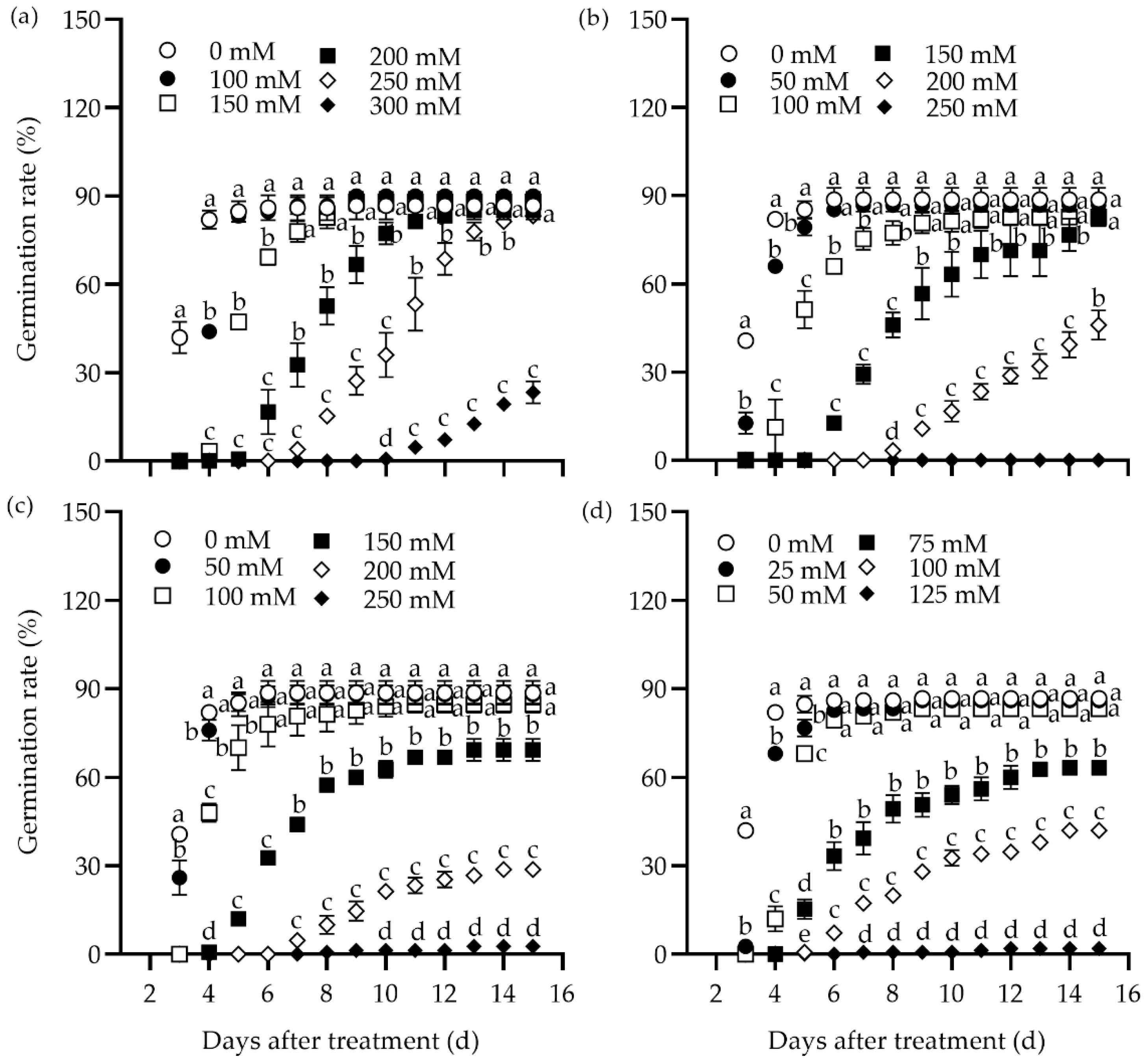
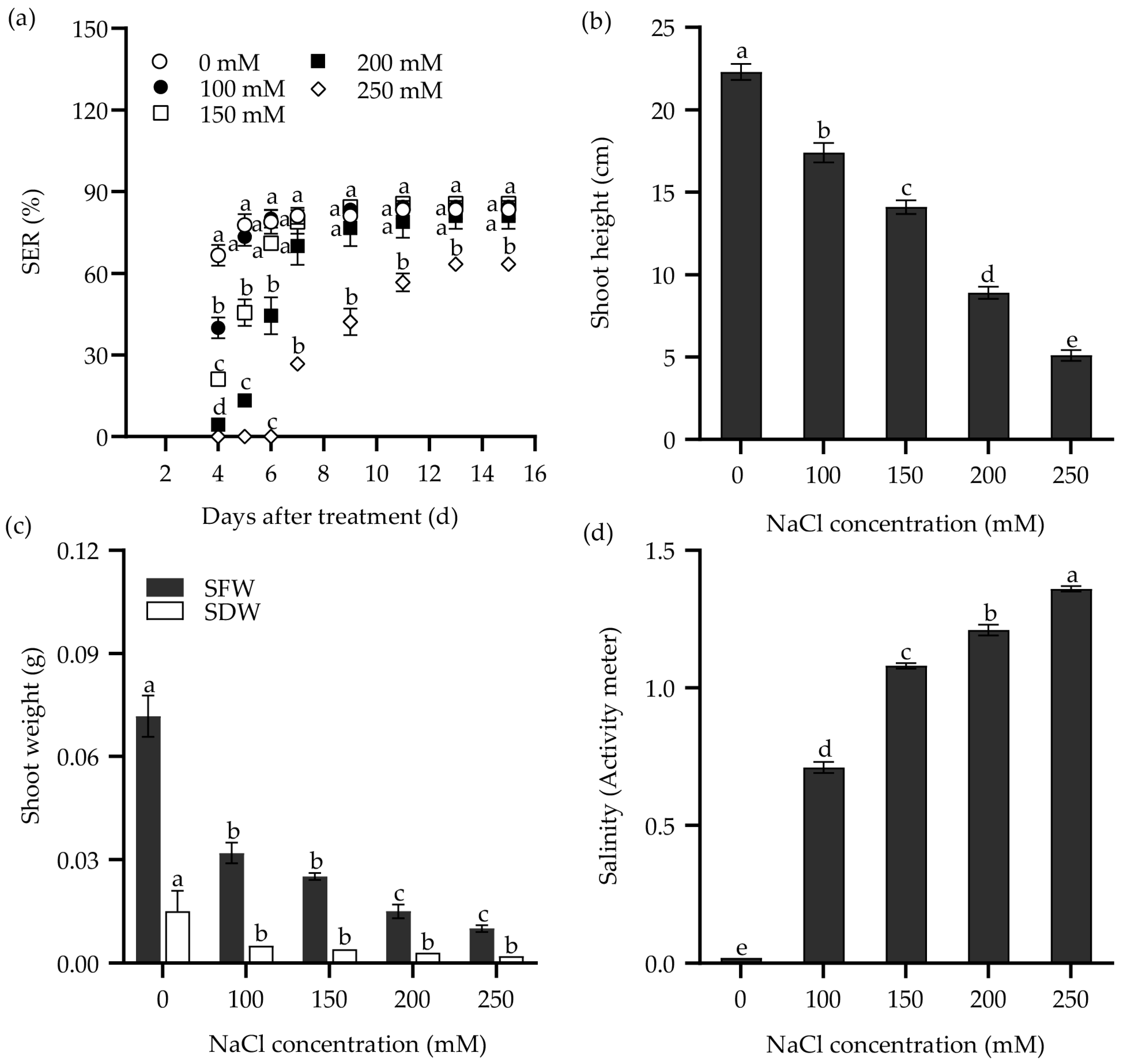
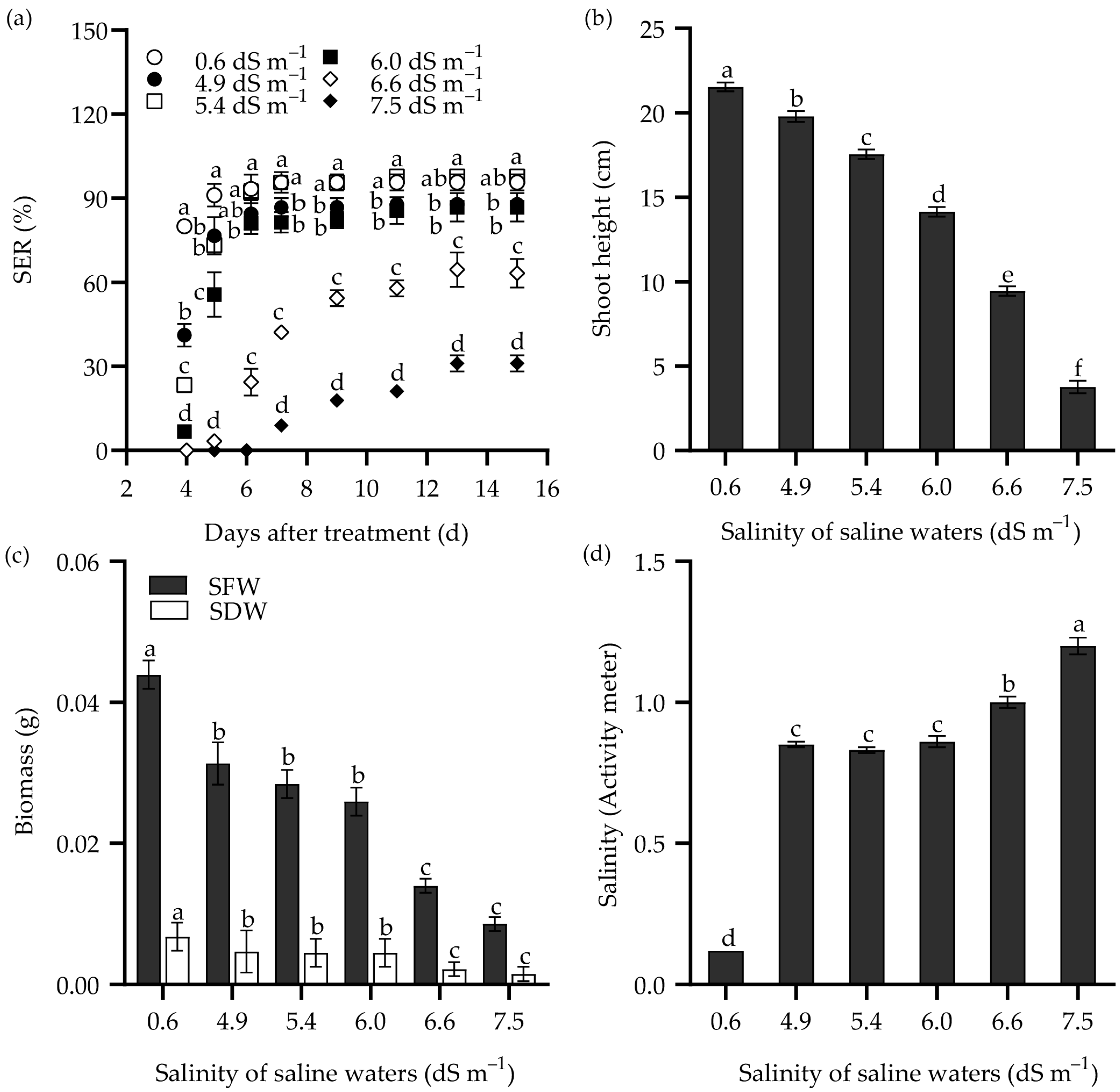

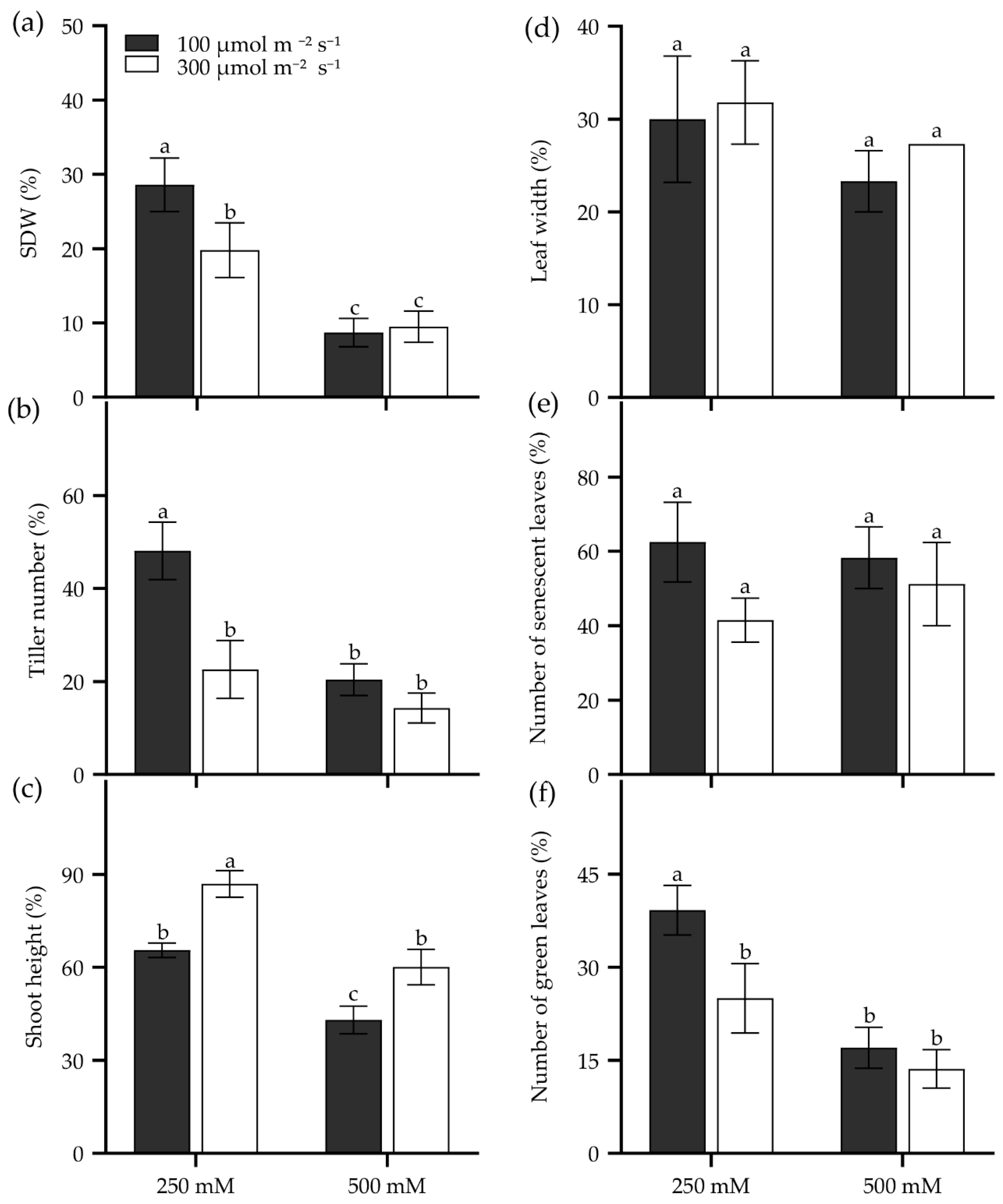
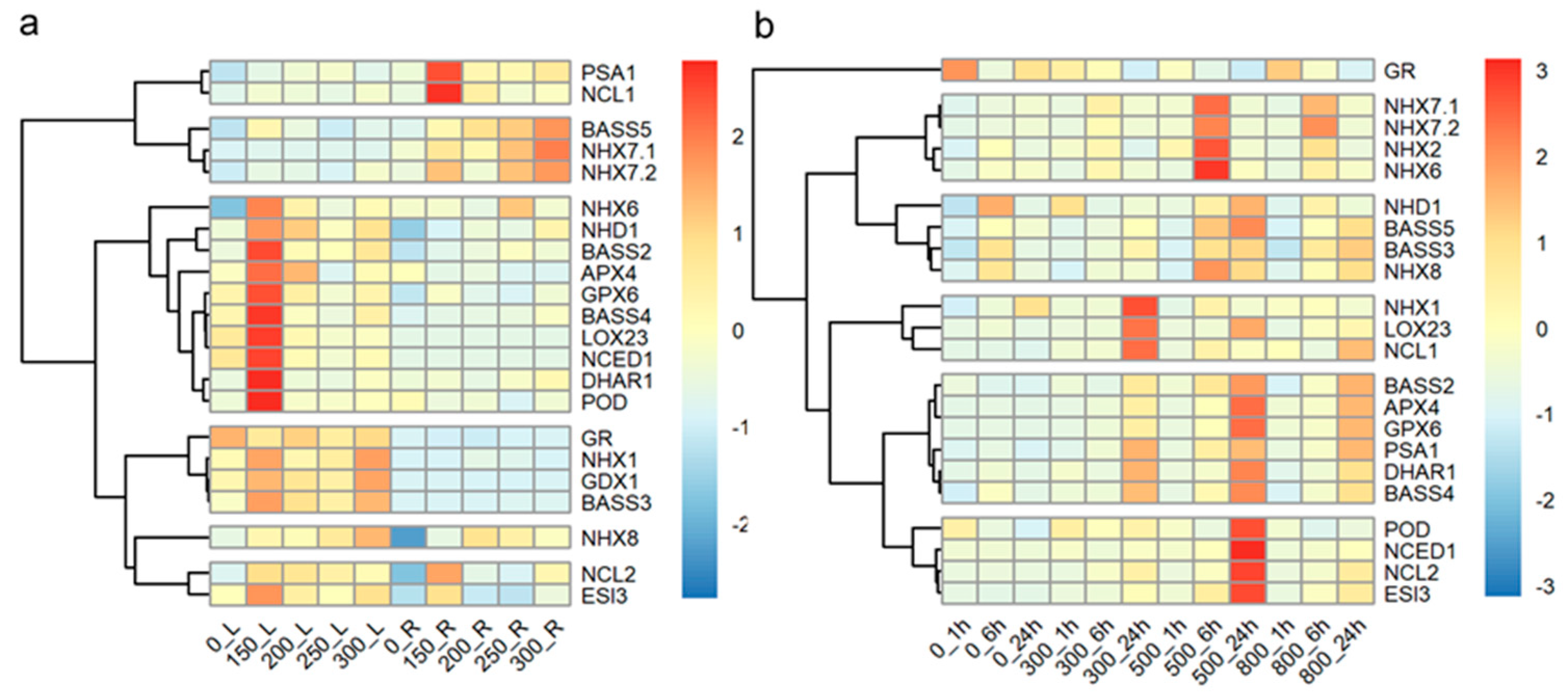
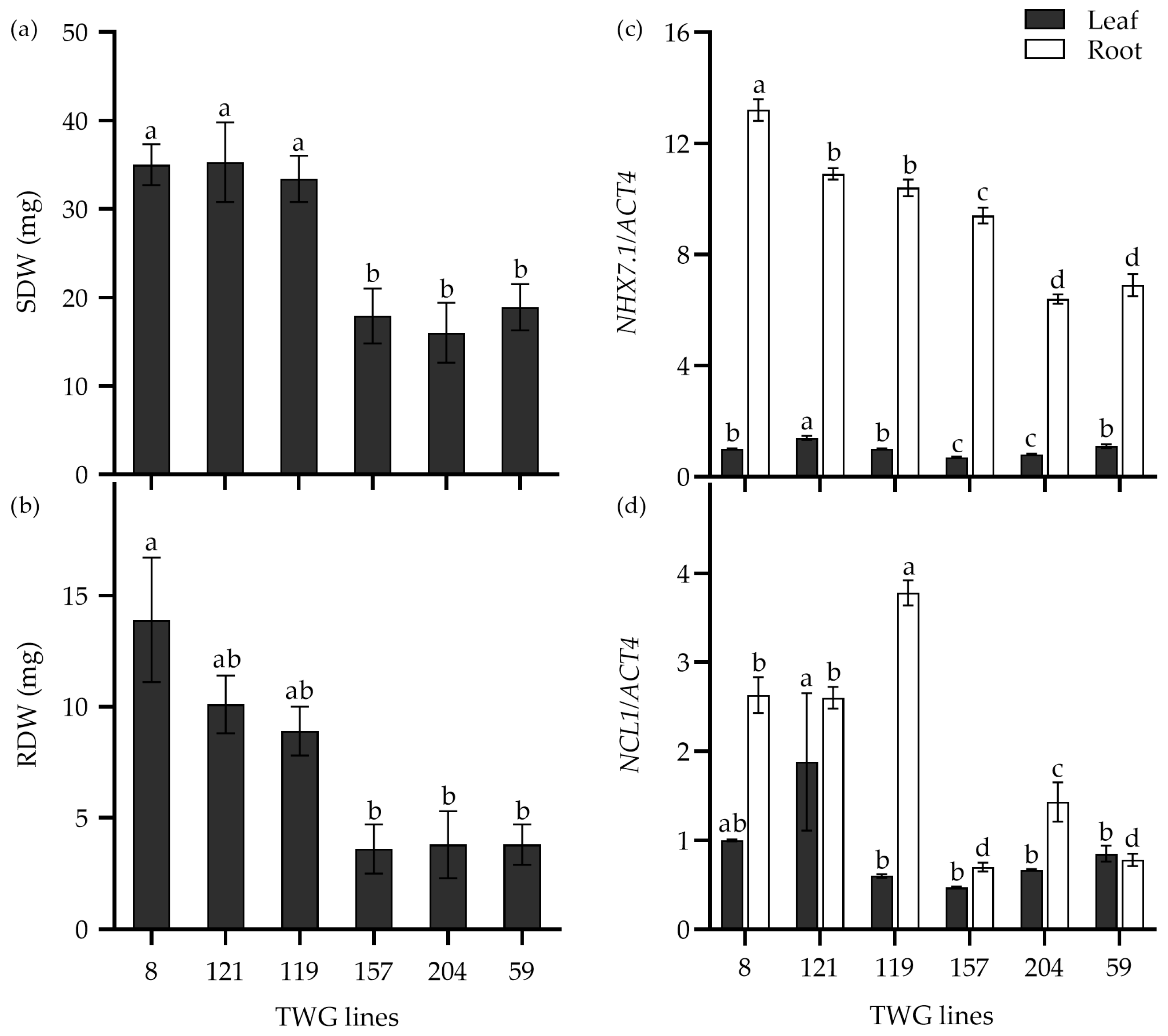
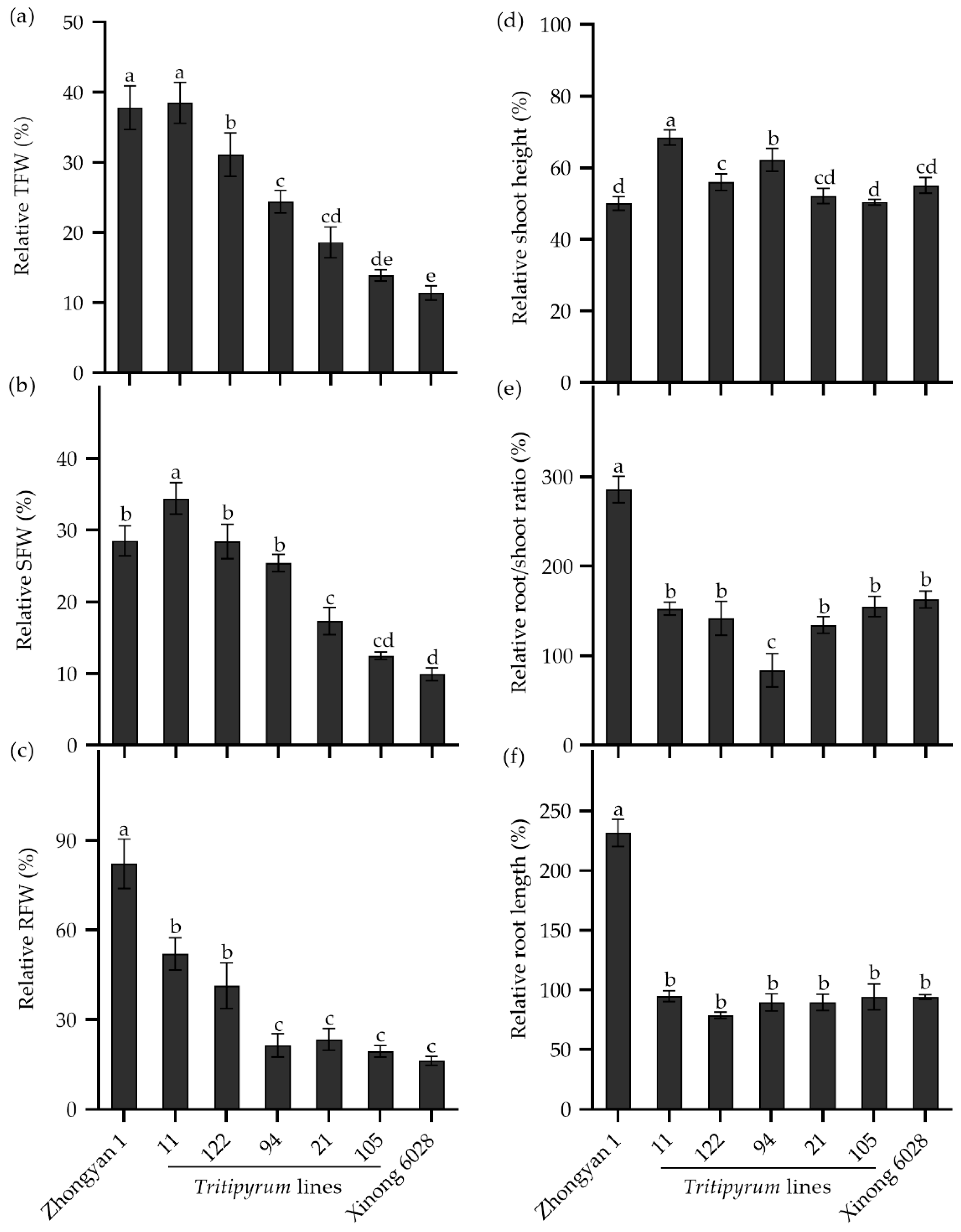
| Lines | Seed Germination Test | RER (%) | Seedling Growth Test | ||||||||||||||
|---|---|---|---|---|---|---|---|---|---|---|---|---|---|---|---|---|---|
| RGR (%) | RDR (%) | RGI (%) | RSH (%) | RVI (%) | SFW (g) | RFW (g) | TFW (g) | SDW (g) | RDW (g) | TDW (g) | |||||||
| NaCl | Na2CO3 | NaCl | Na2CO3 | NaCl | Na2CO3 | NaCl | Na2CO3 | NaCl | Na2CO3 | ||||||||
| TWG8 | 43.5 | 28.2 | 56.5 | 71.8 | 15.0 | 11.9 | 23.5 | 18.9 | 2.2 | 0.9 | 118.5 | 0.168 | 0.100 | 0.268 | 0.036 | 0.011 | 0.046 |
| TWG216 | 50.4 | 30.7 | 49.6 | 69.3 | 18.6 | 12.7 | 29.0 | 20.0 | 4.4 | 2.7 | 96.6 | 0.104 | 0.056 | 0.160 | 0.024 | 0.008 | 0.031 |
| TWG223 | 45.6 | 44.1 | 54.4 | 55.9 | 19.7 | 18.4 | 24.7 | 25.3 | 4.2 | 3.5 | 85.7 | 0.123 | 0.085 | 0.208 | 0.026 | 0.010 | 0.036 |
| TWG86 | 45.2 | 15.9 | 54.8 | 84.1 | 17.4 | 6.8 | 31.8 | 15.6 | 5.9 | 0.9 | 96.7 | 0.152 | 0.082 | 0.234 | 0.032 | 0.009 | 0.041 |
| TWG22 | 38.5 | 13.9 | 61.5 | 86.1 | 15.2 | 5.6 | 21.9 | 13.1 | 3.2 | 0.8 | 104.9 | 0.164 | 0.092 | 0.255 | 0.035 | 0.010 | 0.045 |
| Group 1 | 44.7 a | 26.6 a | 55.3 b | 73.4 b | 17.2 a | 11.1 a | 26.2 a | 18.6 a | 4.0 a | 1.8 a | 100.5 a | 0.142 a | 0.083 a | 0.225 a | 0.030 a | 0.009 a | 0.039 a |
| TWG31 | 49.6 | 10.9 | 50.4 | 89.1 | 19.6 | 4.5 | 30.2 | 9.3 | 5.9 | 0.5 | 57.0 | 0.116 | 0.055 | 0.171 | 0.023 | 0.008 | 0.031 |
| TWG90 | 48.0 | 11.2 | 52.0 | 88.8 | 17.9 | 4.3 | 26.2 | 10.2 | 5.1 | 0.3 | 54.2 | 0.140 | 0.086 | 0.226 | 0.028 | 0.009 | 0.037 |
| TWG182 | 48.6 | 11.4 | 51.4 | 88.6 | 20.1 | 4.8 | 28.3 | 8.6 | 5.3 | 0.8 | 52.9 | 0.101 | 0.063 | 0.163 | 0.023 | 0.008 | 0.030 |
| TWG48 | 39.5 | 17.1 | 60.5 | 82.9 | 19.4 | 9.3 | 21.5 | 8.0 | 4.9 | 1.0 | 60.4 | 0.085 | 0.042 | 0.126 | 0.018 | 0.005 | 0.023 |
| TWG88 | 38.6 | 8.7 | 61.4 | 91.3 | 16.1 | 4.0 | 27.4 | 6.4 | 3.8 | 0.2 | 54.0 | 0.160 | 0.093 | 0.252 | 0.035 | 0.011 | 0.046 |
| TWG30 | 48.1 | 26.7 | 51.9 | 73.3 | 21.3 | 10.4 | 37.0 | 17.5 | 6.0 | 1.5 | 64.1 | 0.139 | 0.066 | 0.204 | 0.032 | 0.009 | 0.040 |
| TWG209 | 42.1 | 36.4 | 57.9 | 63.6 | 16.6 | 14.7 | 31.9 | 30.1 | 4.8 | 4.1 | 43.0 | 0.126 | 0.076 | 0.202 | 0.028 | 0.011 | 0.039 |
| TWG214 | 42.7 | 32.1 | 57.3 | 67.9 | 16.8 | 15.6 | 27.9 | 24.7 | 4.9 | 2.5 | 39.7 | 0.116 | 0.064 | 0.179 | 0.024 | 0.007 | 0.031 |
| Group 2 | 44.7 a | 19.3 ab | 55.3 bb | 80.7 ab | 18.5 a | 8.4 a | 28.8 a | 14.3 ab | 5.1 a | 1. 4ab | 53.2 b | 0.123 ab | 0.068 a | 0.190 ab | 0.026 ab | 0.009 a | 0.035 ab |
| TWG9 | 34.3 | 5.7 | 65.7 | 94.3 | 14.3 | 2.7 | 15.3 | 2.1 | 4.2 | 0.1 | 20.3 | 0.142 | 0.083 | 0.224 | 0.029 | 0.009 | 0.038 |
| TWG15 | 29.9 | 16.8 | 70.1 | 83.2 | 10.4 | 6.3 | 18.0 | 15.6 | 2.1 | 0.9 | 44.6 | 0.089 | 0.055 | 0.144 | 0.021 | 0.007 | 0.028 |
| TWG65 | 9.9 | 3.3 | 90.1 | 96.7 | 4.2 | 1.2 | 9.6 | 2.2 | 0.4 | 0.0 | 50.3 | 0.122 | 0.071 | 0.192 | 0.025 | 0.007 | 0.032 |
| TWG105 | 15.2 | 11.6 | 84.8 | 88.4 | 5.4 | 4.9 | 11.0 | 13.3 | 0.3 | 0.7 | 16.5 | 0.138 | 0.079 | 0.218 | 0.030 | 0.011 | 0.040 |
| TWG106 | 13.8 | 2.3 | 86.2 | 97.7 | 5.8 | 1.0 | 10.0 | 1.1 | 0.6 | 0.0 | 22.8 | 0.110 | 0.067 | 0.177 | 0.023 | 0.007 | 0.029 |
| TWG164 | 18.4 | 5.7 | 81.6 | 94.3 | 7.4 | 2.3 | 18.6 | 5.4 | 1.4 | 0.2 | 22.2 | 0.108 | 0.063 | 0.171 | 0.023 | 0.008 | 0.030 |
| TWG180 | 15.8 | 18.7 | 84.2 | 81.3 | 6.3 | 8.0 | 10.6 | 14.1 | 0.8 | 1.0 | 28.1 | 0.127 | 0.086 | 0.212 | 0.027 | 0.009 | 0.035 |
| TWG185 | 13.9 | 10.2 | 86.1 | 89.8 | 5.1 | 4.2 | 11.0 | 10.5 | 0.6 | 0.4 | 30.5 | 0.115 | 0.048 | 0.163 | 0.023 | 0.006 | 0.028 |
| TWG186 | 26.3 | 1.7 | 73.7 | 98.3 | 9.5 | 0.6 | 17.3 | 2.0 | 1.5 | 0.0 | 12.6 | 0.116 | 0.062 | 0.177 | 0.025 | 0.008 | 0.032 |
| TWG213 | 27.3 | 16.4 | 72.7 | 83.6 | 10.2 | 6.2 | 19.8 | 12.1 | 2.1 | 0.7 | 9.3 | 0.097 | 0.054 | 0.151 | 0.021 | 0.008 | 0.029 |
| Group 3 | 20.5 b | 9.2 b | 79.5 a | 90.8 a | 7.9 b | 3.7 b | 14.1 b | 7.8 b | 1.4 b | 0.4 b | 25.7 c | 0.116 b | 0.067 a | 0.183 b | 0.025 b | 0.008 a | 0.032 b |
| TWG52 | 68.5 | 58.7 | 31.5 | 41.3 | 28.1 | 28.0 | 42.4 | 31.5 | 11.8 | 7.6 | 92.6 | 0.137 | 0.083 | 0.219 | 0.028 | 0.010 | 0.038 |
| TWG70 | 67.7 | 40.0 | 32.3 | 60.0 | 30.9 | 18.5 | 32.0 | 22.1 | 10.9 | 3.9 | 103.7 | 0.093 | 0.055 | 0.148 | 0.022 | 0.009 | 0.031 |
| Group 4 | 68.1 | 49.35 | 31.9 | 50.65 | 29.5 | 23.25 | 37.2 | 26.8 | 11.35 | 5.75 | 98.2 | 0.115 | 0.069 | 0.1835 | 0.025 | 0.010 | 0.035 |
| TWG40 | 50.6 | 8.0 | 49.4 | 92.0 | 20.7 | 3.1 | 22.2 | 1.5 | 5.7 | 0.0 | 82.8 | 0.113 | 0.067 | 0.180 | 0.028 | 0.010 | 0.037 |
| TWG157 | 64.9 | 2.1 | 35.1 | 97.9 | 29.2 | 1.0 | 26.2 | 1.1 | 8.4 | 0.0 | 108.7 | 0.122 | 0.079 | 0.201 | 0.027 | 0.014 | 0.041 |
| Group 5 | 57.8 | 5.1 | 42.3 | 95.0 | 25.0 | 2.1 | 24.2 | 1.3 | 7.05 | 0.0 | 95.8 | 0.118 | 0.073 | 0.191 | 0.028 | 0.012 | 0.039 |
| TWG206(Group 6) | 27.7 | 48.2 | 72.3 | 51.8 | 9.5 | 20.3 | 15.4 | 24.3 | 1.2 | 4.6 | 24.1 | 0.123 | 0.052 | 0.174 | 0.026 | 0.006 | 0.032 |
Disclaimer/Publisher’s Note: The statements, opinions and data contained in all publications are solely those of the individual author(s) and contributor(s) and not of MDPI and/or the editor(s). MDPI and/or the editor(s) disclaim responsibility for any injury to people or property resulting from any ideas, methods, instructions or products referred to in the content. |
© 2025 by the authors. Licensee MDPI, Basel, Switzerland. This article is an open access article distributed under the terms and conditions of the Creative Commons Attribution (CC BY) license (https://creativecommons.org/licenses/by/4.0/).
Share and Cite
Xiao, Q.; Li, W.; Hu, P.; Cheng, J.; Zheng, Q.; Li, H.; Li, Z. An Integrated Method for Evaluation of Salt Tolerance in a Tall Wheatgrass Breeding Program. Plants 2025, 14, 983. https://doi.org/10.3390/plants14070983
Xiao Q, Li W, Hu P, Cheng J, Zheng Q, Li H, Li Z. An Integrated Method for Evaluation of Salt Tolerance in a Tall Wheatgrass Breeding Program. Plants. 2025; 14(7):983. https://doi.org/10.3390/plants14070983
Chicago/Turabian StyleXiao, Qiang, Wei Li, Pan Hu, Jianfeng Cheng, Qi Zheng, Hongwei Li, and Zhensheng Li. 2025. "An Integrated Method for Evaluation of Salt Tolerance in a Tall Wheatgrass Breeding Program" Plants 14, no. 7: 983. https://doi.org/10.3390/plants14070983
APA StyleXiao, Q., Li, W., Hu, P., Cheng, J., Zheng, Q., Li, H., & Li, Z. (2025). An Integrated Method for Evaluation of Salt Tolerance in a Tall Wheatgrass Breeding Program. Plants, 14(7), 983. https://doi.org/10.3390/plants14070983






